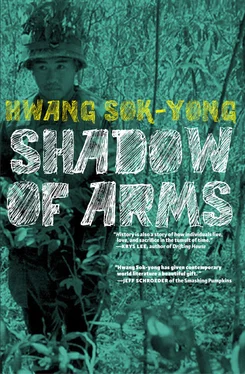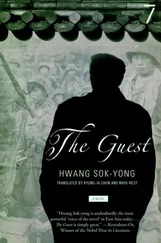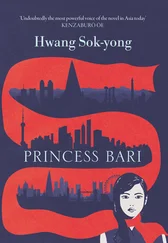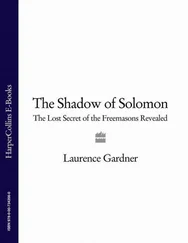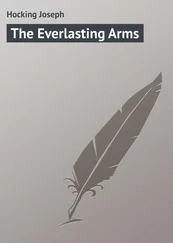“Would you care for a drink, sir?”
“No, thank you. Wake up the general for me.”
The butler tiptoed upstairs. After a while he reappeared and told Quyen that the general would be down shortly. At first the major stood at attention, but when he realized it could be some time, he turned around and relaxed. He gazed out at the South China Sea. The waves were a pale bluish green. At the far end of the bay could be seen several large transport vessels. Down through the glass, a small US patrol boat could be seen stealthily making its rounds to the outer piers of Da Nang Harbor.
“Bonjour.”
Quyen turned around. A fair-skinned woman in a long crimson Chinese gown slit to the thigh was slowly descending the stairs. Her sleepy eyes suggested she was only half-awake. At the end of her limp fingers was a burning cigarette.
“Sorry to have to awaken you from a sweet sleep, madam,” Quyen said in French. But the woman responded in a southern dialect of Vietnamese.
“You’re Major Pham, aren’t you? The general told me about you many times. A very fine officer, he said.”
“Thank you.”
“I arrived from Saigon yesterday. Saigon is tremendously. .”
“Yes, it’s a fine place.”
“No, I mean, it’s extremely violent. An offensive?”
“The worst is over. As you can see, it’s very peaceful here.”
The major recognized her at once. While packing the general’s travel kit, he had noticed a picture of a striking woman in a Singaporean magazine. She was probably half-French. Now he understood why the general had been traveling to Saigon so frequently. He would have done the same. Her hair was reddish-brown, her frame small like an Oriental woman, and her skin an amber color, lighter than the typical Vietnamese. Standing there on the carpet, she kept curling up and stretching out the toes of her tiny bare feet, and then she stood on one foot as she spoke. Quyen felt an urge to crush her feet with his heavy army boots.
“Is there some event today?”
“Yes, we have to cut the tape to dedicate a new resettlement village.”
“Resettlement village?” the woman huffed scornfully, a sarcastic smile on her lips.
Pham Quyen snapped to attention. The general was coming down the stairs in a Hawaiian shirt and golf pants. His salt and pepper hair was cut short, his nose was hooked and his lips were very thin. His stature was on the short side but he seemed to have an iron constitution. He clenched a pipe in his teeth. In his usual cold manner, the general said, “At ease. Have a seat.”
Pham Quyen remained standing. The general looked back at the woman. “Why don’t you change?”
She nodded, gave the general a peck on the cheek, and withdrew. The general looked up at the clock on the wall.
“What brings you here?”
“Sir, today is the dedication for the new resettlement village in An Diem.”
The general frowned slightly. “The mayor of Hoi An can attend to such things, can’t he?”
Without hesitation, Pham Quyen replied, “No, sir. Your Excellency must attend.”
Rather than showing any displeasure or surprise, the general changed his tone to one of consultation.
“Ah, I see. Brief me.”
As if he had expected this, the major removed a notebook scribbled with numbers and notes in very small handwriting from the pocket of his jacket. The heading read “ Tonh Sinh Phuoc Tho ” or “New Life Hamlets.” There were a number of infrastructure details that needed attention, like dams and watercourses; a center for disabled veterans; and then information on troop movements and so on. The phoenix hamlets program was just a new name for the old strategic hamlets resettlement program initiated by the USOM9. Now it was a larger-scale pacification program jointly conducted by representatives of AID, the US advisory group, and the Vietnamese government. But the man in charge of preparing and implementing the budget for the entire project was the provincial governor. The general and his staff had established the plan and Pham Quyen headed it. The US advised and handled all implementation requisitions.
“In our Quang Nam Province, sixty hamlets have already been successfully settled. Our aim is to build phoenix hamlets at three hundred sites.”
“Skip the overview. Tell me about the strategic hamlets in An Diem.”
“Your Excellency, they’re not strategic hamlets anymore; they’re phoenix hamlets.”
“Right, phoenix hamlets. .”
“Yes, and our plan is to build twelve phoenix hamlets in An Diem, and the one today is a model and the largest. Fifteen hundred residents.”
“What are we going to have them do?”
“As soon as they’re settled, they’ll be given land around An Diem valley. The plots will be one or two acres, and they’ll farm and raise cattle. With the money from AID we’ve built three hundred houses, enclosed a plot of common community land with wire fences, built a public hall and a warehouse, and we’re planning to construct schools for the An Diem district.”
“Mmmm, there’s nothing special about it, is there?”
“Your Excellency, we also have a significant interest in parts of this program. In fact, the potential is great. Our office just today received five thousand sacks of fertilizer and thirty truckloads of cement, and that’s just the beginning of the An Diem program.”
“You’re right. I probably should attend the ceremony myself. Who all is coming?”
“The US Marines division commander, the chief of the AID mission, the chief of the Hoi An district advisory group, and the mayor of Hoi An are expected.”
“Will there be speeches?”
“Yes, the AID mission chief and Your Excellency will deliver speeches. Yours has been typed and is waiting at the office.”
“I see, thank you. I’ll be there.”
Pham Quyen sprang to his feet.
“My business here is concluded and I shall return, sir.”
“Sit down, young man. By the time you get back, it’ll be siesta. Have lunch here and we’ll leave together.”
The general returned to his room and Quyen again sat idly on the sofa. He picked his notebook up from the table to put it back in his pocket, but something occurred to him and he opened it again, checking carefully to see nothing was amiss.
The capital of Quang Nam Province was Da Nang, a city of two hundred thousand with a possibility of doubling its population as the war expanded. Including the vast uplands inhabited by the highland tribes, the population of Quang Nam was over one million. Route 1 ran up the shore north of Da Nang, over the Aibanh Hills, and then reached the old city of Hue, finally meeting the border with North Vietnam just above Quang Tri.
The Thu Bon River has two branches in its watershed: one has its source near An Diem in the northwest and the other runs from An Hoa in the southwest. The two branches meet at Hoi An, forming a huge lake close by the sea, and then water flows in and out of ocean estuaries down to Tam Ky and Chu Lai. Da Nang is at one of the mouths of the Thu Bon River. The plain southwest of Da Nang is occupied by a US Air Force base. The Dong Dao Hills in front of Da Nang are a US Marine defensive encampment.
The long and rugged Atwat Mountains out beyond the Allied defense line were a region held by the NLF. Hoi An, a city of about forty thousand on the fertile Thu Bon Delta, stands along a lake that slips into the sea. It has been known for centuries as a center for trade in cinnamon, lumber, and silk. About a hundred thousand more people live in the valleys and plain spread out along the surrounding tributary streams. Even with this fertile land, Quang Nam Province had recently had to import twenty thousand tons of rice yearly from the Mekong Delta to feed the urban populations that were constantly being swollen by war refugees. More and more farming land had been transformed by the war into wasteland.
Читать дальше
